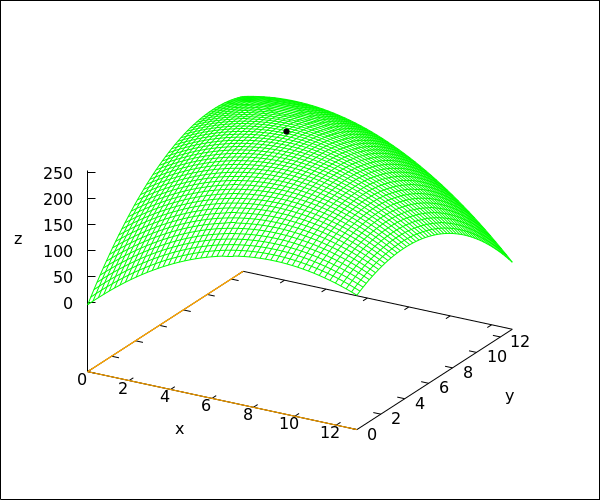Multivariate functions: Stationary points
 Minimum, maximum, and saddle point
Minimum, maximum, and saddle point
The concepts of local minimum and local maximum are already known to us for functions of a single variable. The function \(f(x)\) has a local minimum in \(x=a\) if the graph near \(x=a\) lies above \(f(a)\), more precisely, if there is an open interval \(\ivoo{c}{d}\) around \(a\) (that is to say, there are numbers #c\lt a# and #d\gt a#) such that \(f(x)\ge f(a)\) for all \(x\) from \(\ivoo{c}{d}\). For the definition in the case of a function of two variables, we replace the open interval by an open disk.
Local extremes
Let #\epsilon# be a positive number. The open disk around a point #p# of #{\mathbb R}^2# of radius #\epsilon# is the subset #S_{p,\epsilon}# of #{\mathbb R}^2# consisting of all points #q\in {\mathbb R}^2# at distance less than #\epsilon# to #p#. In a formula: \[S_{p,\epsilon}=\left\{q\in{\mathbb R}^2\mid \sqrt{(p_1-q_1)^2 + (p_2-q_2)^2}\lt \epsilon\right\}\tiny.\]
Let #f# be a bivariate function with domain #D# and let #p# be a point of #D#.
- The point #p# is called a local minimum of #f# if there is an open disk #S# around #p# (a set of the form #S=S_{p,\epsilon}#) for a suitable value of #\epsilon# so #f(q)\ge f(p)# for all #q\in D\cap S#.
- The point #p# is called a local maximum of #f# if there is an open disk #S# around #p# so #f(q)\le f(p)# for all #q\in D\cap S#
- The point #p# is called a saddle point of #f# if it is a stationary point, but in every open disk around #p# there are points \(q\) and \(r\) such that \(f(q)\gt f(p)\) and \(f(r)\lt f(p)\).
Below you see the graph of the function \[f(x,y)=\tfrac{1}{2}\!\left((1-(x-\tfrac{1}{2})^2-(y-\tfrac{1}{2})^2\right)\]

This function has the following partial derivatives: \[f_x(x,y)=\tfrac{1}{2}-x\qquad\text{and}\qquad f_y(x,y)=\tfrac{1}{2}-y\] In the point \(\rv{\tfrac{1}{2},\tfrac{1}{2}}\), both derivatives are zero. This point is a stationary point. The function has a maximum value there.
The notion of saddle point is similar to the notion of inflection point for a stationary point of a function of a single variable.
Here is a generalization of the theorem Local extrema are stationary points for one variable.
If #f# a bivariate differentiable function on a domain #D# and #p# is a local minimum or local maximum of #f#, then #p# is a stationary point of #f#.
The proof is simple: Write #p=\rv{a,b}#. Then #a# is a local minimum or maximum of the differentiable function #f(a,y)# in the variable #y#. The theorem Local extrema are stationary points for the case of one variable gives \[\left.\frac{\partial f(x,y)}{\partial y}\right|_{\rv{a,b}}=\left.\frac{\dd f(a,y)}{\dd y}\right|_{b}=0\tiny.\] Similarly, we have \[\left.\frac{\partial f(x,y)}{\partial x}\right|_{\rv{a,b}}=\left.\frac{\dd f(x,b)}{\dd x}\right|_{a}=0\tiny.\] This means that #p=\rv{a,b}# is a stationary point of #f#.
Saddle points are by definition stationary points that are neither a local minimum nor a local maximum. The definition of a saddle point is even chosen so that a stationary point of #f# is always a local minimum, local maximum, or saddle point.
As with functions of one variable, for differentiable functions of two variables, the requirement that a point is a stationary point is necessary but not sufficient for a point to be a local minimum or a local maximum. We give a counterexample.
Below is the graph of the function \[f(x,y)=\tfrac{1}{2}\!\left((1-(x-\tfrac{1}{2})^2+(y-\tfrac{1}{2})^2\right)\]

This function has the following partial derivatives: \[f_x(x,y)=\tfrac{1}{2}-x\phantom{quad}\text{and}\phantom{quad}f_y(x,y)=y-\tfrac{1}{2}\] At the point \(\tfrac{1}{2},\tfrac{1}{2}\) both derivatives are zero again. But the coordinate line in the direction of the \(x\)-axis is a downward parabola, and the coordinate line in the direction of the \(y\)-axis is an upward parabola. Therefore, the point \(\rv{\tfrac{1}{2},\tfrac{1}{2}}\) must be a saddle point.
Since a local maximum of a multivariate differentiable function is a stationary point, we first calculate the stationary points. The partial derivatives of #f# are \[f_x(x,y)=-4\cdot x-2\cdot y+36\phantom{quad}\text{and}\phantom{quad}f_y(x,y)=-2\cdot x-4\cdot y+42\tiny.\] The stationary points are the solutions of the system of equations \[\lineqs{-4\cdot x-2\cdot y+36&=&0\cr -2\cdot x-4\cdot y+42&=&0\cr}\]
This system has exactly one solution: #{x = 5\land y = 8}#. We conclude that there is exactly one stationary point: #\rv{5, 8}#. It is given that #f# has a local maximum, so this point must be the answer: #\rv{5, 8}#.
The graph of the function #f# is shown in the figure below. The point #\rv{5,8,254}# corresponding to the local maximum is indicated by a small black disk.

Or visit omptest.org if jou are taking an OMPT exam.



